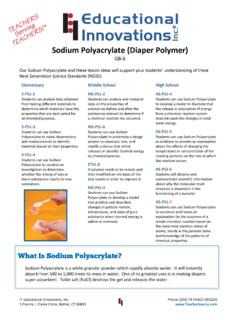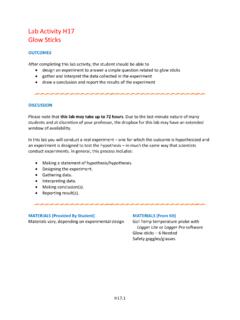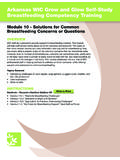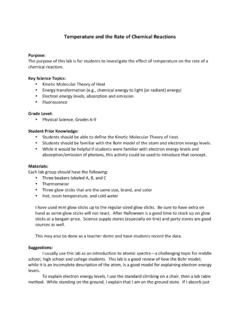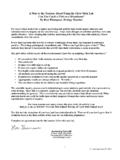Transcription of Glo Germ Classroom Kit Lessons - Educational Innovations
1 Glo germ Classroom Kit Lessons GLO-210. A brief history of epidemiology Many ancient peoples thought that disease was a punishment imposed by the gods for bad behavior. The ideas of Galen of Pergamon, a Roman physician who lived around 200 AD, influenced Western medicine for nearly 2000 years. One of his theories was that disease was caused by miasma, a poisonous vapor which carried particles of rotting materials. This idea made sense to people who knew that eating spoiled food, drinking dirty water, or breathing polluted air could make you sick. People did not know that microorganisms existed, and they didn't realize that disease could be Galen of Pergamum, passed from a sick person to another, healthy individual. undated lithograph In 1594, Girolamo Fracastoro, a doctor in Verona, Italy, proposed that the invisible, disease-causing particles in miasma were living organisms, but until Dutch scientist Anton van Leeuwenhoek invented a microscope powerful enough to see microorganisms there was no evidence that a germ theory of disease might be true.
2 It took centuries and the work of many physicians and scientists to actually prove van Leeuwenhoek's theory. In 1844 another Italian scientist, Agostino Bassi, proved that a microscopic fungus caused disease in silkworms. Three years later, Ignaz Semmelweis dramatically reduced deaths due to puerperal fever in his hospital in Vienna when he required that physicians wash their hands in chlorinated lime solutions before attending patients. French scientist Louis Pasteur published a paper in 1862 in which he explained that microorganisms caused spoilage and fermentation in foods, and suggested that chemical solutions could be used to destroy harmful germs. Joseph Lister in Glasgow, Scotland, read Pasteur's work and decided to try using carbolic acid solutions to prevent infection in surgical incisions. His successful work was widely published in 1867; soon, surgeons throughout the world began practicing sterile surgery in their own hospitals.
3 German physician Robert Koch succeeded in isolating the bacterium that caused anthrax in 1877, settling the question of whether miasma or germs caused disease once and for all. EPIDEMIOLOGY is defined as the study of the causes, distribution, and control of disease in a population. Dr. John Snow of London, England is often called the father of epidemiology. In 1854, he successfully traced the source of a cholera epidemic in a London suburb by placing a dot on a map of the afflicted area for each person who had contracted the disease. The dots clustered around a particular public water pump. Dr. Snow convinced city officials to remove the 2015 Educational Innovations , Inc. Phone (203) 74-TEACH (83224). 5 Francis J. Clarke Circle Fax (203) 229-0740. Bethel, CT 06801 handle from the pump so it couldn't be used; the outbreak ended. A check of the water company revealed that the water source for that pump was a polluted section of the Thames River.
4 The Centers for Disease Control and Prevention (CDC), part of the Department of Health and Human Services, coordinates epidemiology in the United States. The CDC's mission is to collaborate to create the expertise, information, and tools that people and communities need to protect their health through health promotion, prevention of disease, injury and disability, and preparedness for new health threats. ( ). An outbreak of a certain disease is considered an epidemic if the number of cases is significantly higher than what you'd expect for a particular group of people at a particular time of year. Thus, a few cases of a very rare disease might be considered an epidemic while hundreds of cases of the common cold in winter would not. If the outbreak extends to other countries or continents it is called a pandemic. A disease is endemic if it is typically found in a population without having to be brought in from the outside, for example chickenpox in the United States.
5 National health organizations like the CDC partner with international organizations like the World Health Organization (WHO) to prepare for and control epidemics and pandemics. Bacteria are single-celled organisms too small to be seen by the naked eye. Bacteria are all around us; by some estimates the weight of all the bacteria on Earth is greater than that of the weight of all the plants and animals on Earth combined! ( ). While most bacteria are harmless, and some, such as those that inhabit our intestines, are required to stay healthy, others cause disease. We often refer to disease-causing bacteria, viruses and fungal spores as germs.. Foodborne illnesses, commonly called food poisoning, occurs when you eat or drink food that contains disease-causing bacteria, viruses, or fungi, or the toxins (poisonous substances) A note about lighting: made by them. Food can be contaminated Before presenting any of these through improper processing, improper storage and transport of foods, and improper Lessons , it's important to test the preparation and handling.
6 One of the most darkness of your room to make sure common foodborne illnesses is salmonella that your students will be able to see entercolitis, an infection of the lining of the the Glo germ lotion or powder small intestine, caused by Salmonella bacteria. fluoresce under the ultraviolet light. Ultraviolet light is electromagnetic radiation with wavelengths of 10 nanometers to 400 If you cannot get your room dark nanometers, shorter than visible light but enough, you may have to prepare a longer than x-rays. Some substances, after viewing chamber using a cardboard absorbing ultraviolet light radiation, emit box or a blanket draped over a chair. energy as visible light in a process called fluorescence. Examples include flowers pollinated by insects, which can see ultraviolet light, many minerals, and numerous chemicals which are colorless or white under visible light. 2015 Educational Innovations , Inc.
7 2 lesson 1. Proper Hand Washing Can Help Stop the Spread of Germs and Diseases Introduction: People used to believe that disease was caused by miasma, a poisonous vapor which carried particles of rotting materials that caused illness. People knew that eating spoiled food, drinking dirty water, or breathing polluted air could make you sick, so this idea made sense to people who did not know that microorganisms tiny living creatures too small to be seen by the naked eye . even existed. People did not know that diseases could be passed from one person to another. Even doctors would go from one sick person to another without washing their hands. In 1847. Ignaz Semmelweis dramatically reduced the deaths due to puerperal fever in his hospital in Vienna, Austria when he required that physicians wash their hands in chlorinated lime solutions before touching patients. Hand washing is still the first line of defense in preventing the spread of disease, but if your hands aren't washed properly you can still pass germs to others.
8 Materials: Glo germ Classroom Kit #GLO-210 (contains Glo germ lotion, Glo germ powder, and a UV light). paper towels soap and water x 11 piece of paper and a pencil for each student colored pencils or crayons Directions: Provide each student with a blank piece of paper and a pencil. Ask the students to trace around one of their hands with the pencil and then set both aside. Place a nickel-sized blob of Glo germ lotion onto the palm of one hand of each student. The students should rub the lotion onto both hands, being sure to cover the areas between their fingers and around their fingernails. Any excess lotion should be wiped off with a paper towel. Explain that the lotion contains tiny particles that fluoresce, or glow, under ultraviolet light. Tell students: Today we're pretending that these tiny particles in the lotion are bacteria or germs.. Bacteria are single-celled organisms too small to be seen by the naked eye.
9 Bacteria are all around us; by some estimates the weight of all the bacteria on Earth is greater than that of the weight of all the plants and animals on Earth combined! Most bacteria are harmless and we need some types of bacteria, such as those that inhabit our intestines, to stay healthy. But other bacteria cause disease. We often refer to disease-causing bacteria, viruses and fungal spores as germs. Proper hand washing removes these germs from our skin so we cannot pass them along to other people, or transfer them to our food, eating utensils, toothbrushes etc. 2015 Educational Innovations , Inc. 3 Allow the students to view their germ -covered hands under the ultraviolet lamp. They should notice many glowing areas on their skin, nails and around their cuticles. Instruct students to wash their hands using soap and water the way they usually do, then recheck their hands under the UV light.
10 The effort it takes to completely wash the lotion off one's hands is similar to the effort it takes to remove most bacteria. Did the students remove all of the germs ? Have the students use colored pencils or crayons to mark on the paper tracings of their hands where the germs remained. Compare pictures; did most students leave germs behind in the same locations? What are those problem areas? Did chapped or cracked areas retain more germs than other areas? Tell students: Our skin keeps the microorganisms from getting into our bodies. Germs get into our bodies through cracks and cuts in our skin, so it is important to keep it intact and healthy. If your school already has a hand washing protocol in place, review this with your students. If not, review the following guidelines from the CDC ( ): Hand Washing Guidelines Wet your hands with clean running water (warm or cold) and apply soap.
